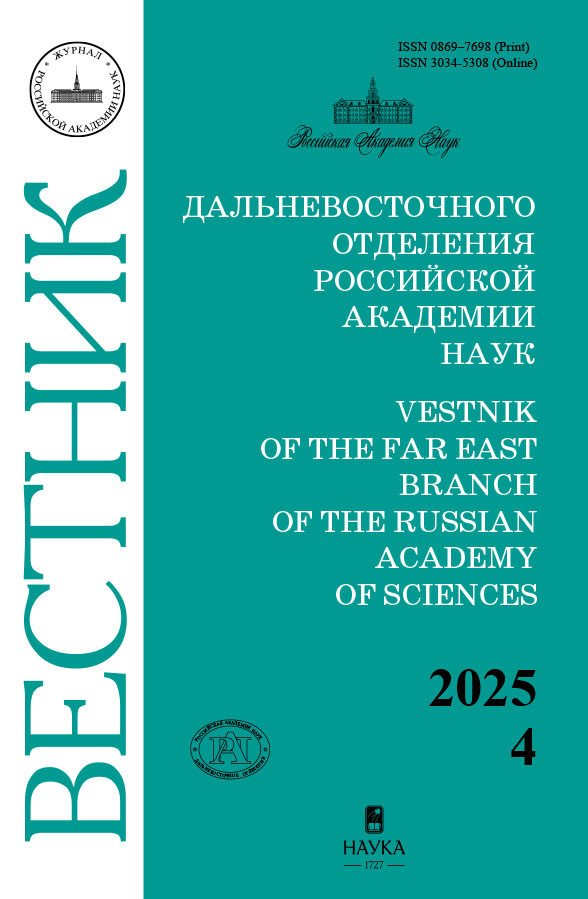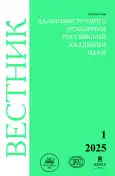Влияние почвенного состава на рост и развитие растений базилика
- Авторы: Кульчин Ю.Н.1, Кожанов С.О.1, Холин А.С.1, Субботин Е.П.1, Субботина Н.И.1
-
Учреждения:
- Институт автоматики и процессов управления ДВО РАН
- Выпуск: № 1 (2025)
- Страницы: 5-18
- Раздел: Биотехнология
- URL: https://journal-vniispk.ru/0869-7698/article/view/307660
- DOI: https://doi.org/10.31857/S0869769825010012
- EDN: https://elibrary.ru/hinddo
- ID: 307660
Цитировать
Полный текст
Аннотация
В работе исследуется развитие растений базилика Ocimum basilicum L. в зависимости от состава почвенной смеси при выращивании с помощью светодиодного излучения в закрытых условиях. Изучалось влияние на растения комбинаций удобрений Кристалон и Цион с песком. Показано, что использование комплексного удобрения Кристалон приводит к наибольшим значениям морфометрических параметров растений базилика. Выращенные с его помощью растения имели значения массы надземной части растений в 45 раз большие, чем контрольные. Применение удобрения Цион привело к увеличению этого параметра относительно контроля в 11 раз. Добавление в смеси песка способствовало снижению массы надземной части растений базилика, выращенных в почвенной смеси с Кристалоном, на 15%, Ционом – на 37%, а в почвенной смеси без добавок – на 7%. Использование удобрения Кристалон позволило вырастить растения базилика, имеющие на 35-й день массу надземной части, равную 14 г, что сравнимо с результатами, получаемыми при помощи беспочвенных методов. Данный результат показывает перспективность использования удобрения Кристалон для выращивания данной культуры в короткие сроки в почве, сохраняя все преимущества данного метода.
Ключевые слова
Об авторах
Ю. Н. Кульчин
Институт автоматики и процессов управления ДВО РАН
Автор, ответственный за переписку.
Email: kulchin@iacp.dvo.ru
Владивосток, Россия
С. О. Кожанов
Институт автоматики и процессов управления ДВО РАН
Email: kozhanov_57@mail.ru
Владивосток, Россия
А. С. Холин
Институт автоматики и процессов управления ДВО РАН
Email: a_kholin@dvo.ru
Владивосток, Россия
Е. П. Субботин
Институт автоматики и процессов управления ДВО РАН
Email: s.e.p@list.ru
Владивосток, Россия
Н. И. Субботина
Институт автоматики и процессов управления ДВО РАН
Email: sale789@mail.ru
Владивосток, Россия
Список литературы
- Bridgewood L. Hydroponics: Soilless gardening explained. Marlborough, UK: Crowood Press, 2003. 141 p.
- Fussy A., Papenbrock J. An overview of soil and soilless cultivation techniques – chances, challenges and the neglected question of sustainability // Plants. 2022. Vol. 11, N9. P. 1153. https://doi.org/10.3390/plants11091153.
- Geilfus C.M. Controlled environment horticulture. Improving Quality of Vegetables and Medicinal Plants. Cham, Switzerland: Springer, 2019. P. 1–233. https://doi.org/10.1007/978-3-030-23197-2.
- Khan F.A. A review on hydroponic greenhouse cultivation for sustainable agriculture // International Journal of Agriculture Environment and Food Sciences. 2018. Vol. 2, N2. P. 59–66. https://doi.org/10.31015/jaefs.18010.
- Sgherri C., Cecconami S., Pinzino C., Navari-Izzo F., Izzo R. Levels of antioxidants and nutraceuticals in basil grown in hydroponics and soil // Food Chemistry. 2010. Vol. 123, N2. P. 416–422. https://doi.org/10.1016/j.foodchem.2010.04.058.
- Maurer D., Sadeh A., Chalupowicz D., Barel S., Shimshoni J.A., Kenigsbuch D. Hydroponic versus soil-based cultivation of sweet basil: impact on plants’ susceptibility to downy mildew and heat stress, storability and total antioxidant capacity // Journal of the Science of Food and Agriculture. 2023. Vol. 103, N15. P. 7809–7815. https://doi.org/10.1002/jsfa.12860.
- Fontana E., Nicola S. Traditional and soilless culture systems to produce corn salad (Valerianella olitoriaL.) and rocket (Eruca sativaMill.) with low nitrate content // J. Food Agric. Environ. 2009. Vol. 7, N2. P. 405–410.
- Buitrago-Villanueva I., Barbosa-Cornelio R., Coy-Barrera E. Influence of the Culture System and Harvest Time on the Specialized Metabolite Composition of Rocket Salad (Eruca sativa) Leaves // Horticulturae. 2023. Vol. 9, N2. P. 235. https://doi.org/10.3390/horticulturae9020235.
- Tavakkoli E., Rengasamy P., McDonald G.K. The response of barley to salinity stress differs between hydroponic and soil systems // Functional Plant Biology. 2010. Vol. 37, N7. P. 621–633. https://doi.org/10.1071/FP09202.
- Makri O., Kintzios S.Ocimumsp. (basil): botany, cultivation, pharmaceutical properties, and biotechnology // J. Herbs, Spices Med. Plants. 2008. Vol. 13, N3. P. 123–150. https://doi.org/10.1300/J044v13n03_10.
- Голубкина Н.А., Маланкина Е.Л., Соловьёва А.Д., Кошелева О.В., Кривенков Л.В., Добруцкая Е.Г. Аккумулирование селена базиликом огородным (Ocimum basilicumL.) // ОвощиРоссии. 2014. Т. 1, № 22. С. 42–47.
- Dou H., Niu G., Gu M., Masabni J.G. Responses of sweet basil to different daily light integrals in photosynthesis, morphology, yield, and nutritional quality // HortScience. 2018. Vol. 53, N4. P. 496–503. https://doi.org/10.21273/HORTSCI12785-17.
- Beaman A.R., Gladon R.J., Schrader J.A. Sweet basil requires an irradiance of 500 μ mol· m-2· s-1for greatest edible biomass production // HortScience. 2009. Vol. 44, N1. P. 64–67. https://doi.org/10.21273/HORTSCI.44.1.64.
- Sipos L., Balázs L., Székely G., Jung A., Sárosi S., Radácsi P., Csambalik L. Optimization of basil (Ocimum basilicumL.) production in LED light environments. A review // Scientia Horticulturae. 2021. Vol. 289. P. 110486. https://doi.org/10.1016/j.scienta.2021.110486.
- Barbi S., Barbieri F., Bertacchini A., Barbieri L., Montorsi M. Effects of different LED light recipes and NPK fertilizers on basil cultivation for automated and integrated horticulture methods //Applied Sciences. 2021. Vol. 11, N6. P. 2497. https://doi.org/10.3390/app11062497.
- Aghaye Noroozlo Y., Souri M.K., Delshad M. Effects of soil application of amino acids, ammonium, and nitrate on nutrient accumulation and growth characteristics of sweet basil // Communications in Soil Science and Plant Analysis. 2019. Vol. 50, N22. P. 2864–2872. https://doi.org/10.1080/00103624.2019.1689249.
- Jabborova D., Ma H., Bellingrath-Kimura S.D., Wirthn S. Impacts of biochar on basil (Ocimum basilicum) growth, root morphological traits, plant biochemical and physiological properties and soil enzymatic activities // Scientia Horticulturae. 2021. Vol. 290. P. 110518. https://doi.org/10.1016/j.scienta.2021.110518.
- Sabra M., Aboulnasr A., Franken P., Perreca E., Wright L.P., Camehl I. Beneficial root endophytic fungi increase growth and quality parameters of sweet basil in heavy metal contaminated soil // Frontiers in Plant Science. 2018. Vol. 9. P. 1726. https://doi.org/10.3389/fpls.2018.01726.
- Chomczyńska M., Zdeb M. The effect of Z-ion Zeolite substrate on growth of Zea maysL. as energy crop growing on marginal soil // Journal of Ecological Engineering. 2019. Vol. 20, N9. P. 253–260. https://doi.org/10.12911/22998993/112482.
- Косандрович С.Ю., Ионова О.В., Солдатов В.С. Композитные ионитные субстраты на основе полимерного ионита и природного клиноптилолита // Известия Национальной академии наук Беларуси. Серия химических наук. 2017. № 4. С. 7–14.
- Chomczyńska M., Soldatov V., Wasąg H., Turski M. Effect of ion exchange substrate on grass root development and cohesion of sandy soil // Int. Agrophys. 2016. Vol. 30,N3. P. 293–300. https://doi.org/10.1515/intag-2015-0095.
- Soldatov V., Pawlowski L., Szymanska M., Chomczyńska M., Matusevich V., Wasag H., Machon A., Kowalik H., Kobusinski P. Application of ion exchange substrates Biona for fertilization of depleted soils and bare sand // Ecological Engineering. 2001. Vol. 18, N2. P. 227–232. https://doi.org/10.1016/S0925-8574(01)00070-2.
- Мамиев Д.М., Кумсиев Э.И., Шалыгина А.А. Эффективность биопрепарата Экстрасол и микроудобрения Кристалон на посевах кукурузы // Горное сельское хозяйство. 2016. № 1. С. 102–108.
- Мамиев Д.М., Доева Л.Ю., Мисик Н.А., Тедеева А.А., Шалыгина А.А. Применение биопрепарата Экстрасол и микроудобрения Кристалон на посевах кукурузы // Земледелие. 2011. № 2. С. 29–31.
- Галимов В.Р., Глаз Н.В., Уфимцева Л.В. Развитие саженцев вишни в зависимости от минеральных подкормок и подвойных комбинаций // Главный агроном. 2019. № 3.
- Kulchin Y.N., Bulgakov V.P., Subbotin E.P., Kholin A.S., Subbotina N.I. Monochromatic LEDs Effect on Rocket (Eruca sativaMill.) Morphogenesis and Productivity // Bull. Russ. Acad. Sci. Phys. 2022. Vol. 86. P. S114–S118. https://doi.org/10.3103/S1062873822700502.
- Shipley B., Vu T.-T. Dry matter content as a measure of dry matter concentration in plants and their parts // New Phytologist. 2002. Vol. 153. P. 359–364. https://doi.org/10.1046/j.0028-646X.2001.00320.x.
- Maeda K., Ahn D.-H. Estimation of Dry Matter Production and Yield Prediction in Greenhouse Cucumber without Destructive Measurements // Agriculture. 2021. Vol. 11. P. 1186. https://doi.org/10.3390/agriculture11121186.
- Abbasvand E., Hassannejad S., Zehtab-Salmasi S., Alizadeh-Salteh S. Physiological and biochemical responses of basil to some allelopathic plant residues and dodder infestation // Acta Physiologiae Plantarum. 2020. Vol. 42. P. 1–13. https://doi.org/10.1007/s11738-019-2990-y.
- Ghazijahani N., Hadavi E., Jeong B.R. Foliar sprays of citric acid and salicylic acid alter the pattern of root acquisition of some minerals in sweet basil (Ocimum basilicumL.) // Frontiers in Plant Science. 2014. Vol. 5. P. 573. https://doi.org/10.3389/fpls.2014.00573.
- Roosta H.R., Sajjadinia A.R. Studying the effect of cold stress on green basil, violet basil, tomato and lettuce using chlorophyll fluorescence technique // Environmental Stresses in Crop Sciences. 2010. Vol. 3, N1. P. 1–8.
- Stetsenko L.A., Pashkovsky P.P., Voloshin R.A., Kreslavski V.D., Kuznetsov V.V., Allakhverdiev S.I. Role of anthocyanin and carotenoids in the adaptation of the photosynthetic apparatus of purple-and green-leaved cultivars of sweet basil (Ocimum basilicum) to high-intensity light // Photosynthetica. 2020. Vol. 58, N4. P. 890–901. doi: 10.32615/ps.2020.048.
- Piovene C., Orsini F., Bosi S., Sanoubar R., Bregola V., Dinelli G., Gianquinto G. Optimal red: blue ratio in led lighting for nutraceutical indoor horticulture // Scientia Horticulturae. 2015. Vol. 193. P. 202–208. https://doi.org/10.1016/j.scienta.2015.07.015.
- Pasch J., Appelbaum S., Palm H.W., Knaus U. Growth of basil (Ocimum basilicum) in aeroponics, DRF, and raft systems with effluents of African catfish (Clarias gariepinus) in decoupled aquaponics (ss) // AgriEngineering. 2021. Vol. 3, N3. P. 559–574. https://doi.org/10.3390/agriengineering3030036.
Дополнительные файлы







